Last summer Arsenal finished the £30m renovation of their London Colney training base. The site includes a revamped ‘Player Performance Centre’, which is something of a hi-tech lair dedicated to the physical and mental welfare of the players. Here be scientists, doctors, physios, masseurs, psychologists, space age gymnastic equipment and the beating heart of Darren Burgess’ operation.
The Australian took over as Arsenal’s Head of High Performance last summer and after a period of review, he has begun to mould the operation into his own image. The tour begins in the players’ changing room situated just before the entrance to the Player Performance Centre. As you would expect, the space is clinically white and as spotless as a surgeon’s scalpel.
Players are still required to remove their shoes and leave them outside of the changing quarters, only sliders can be worn to preserve the spotless mise-en-scene. (We are given dispensation to spare ourselves the indignity of wearing plastic covers on our shoes). The changing quarters are, to coin a phrase, Feng Shui as f*ck, with few physical obstacles to easy movement. The corners of the room are rounded off to encourage integration.
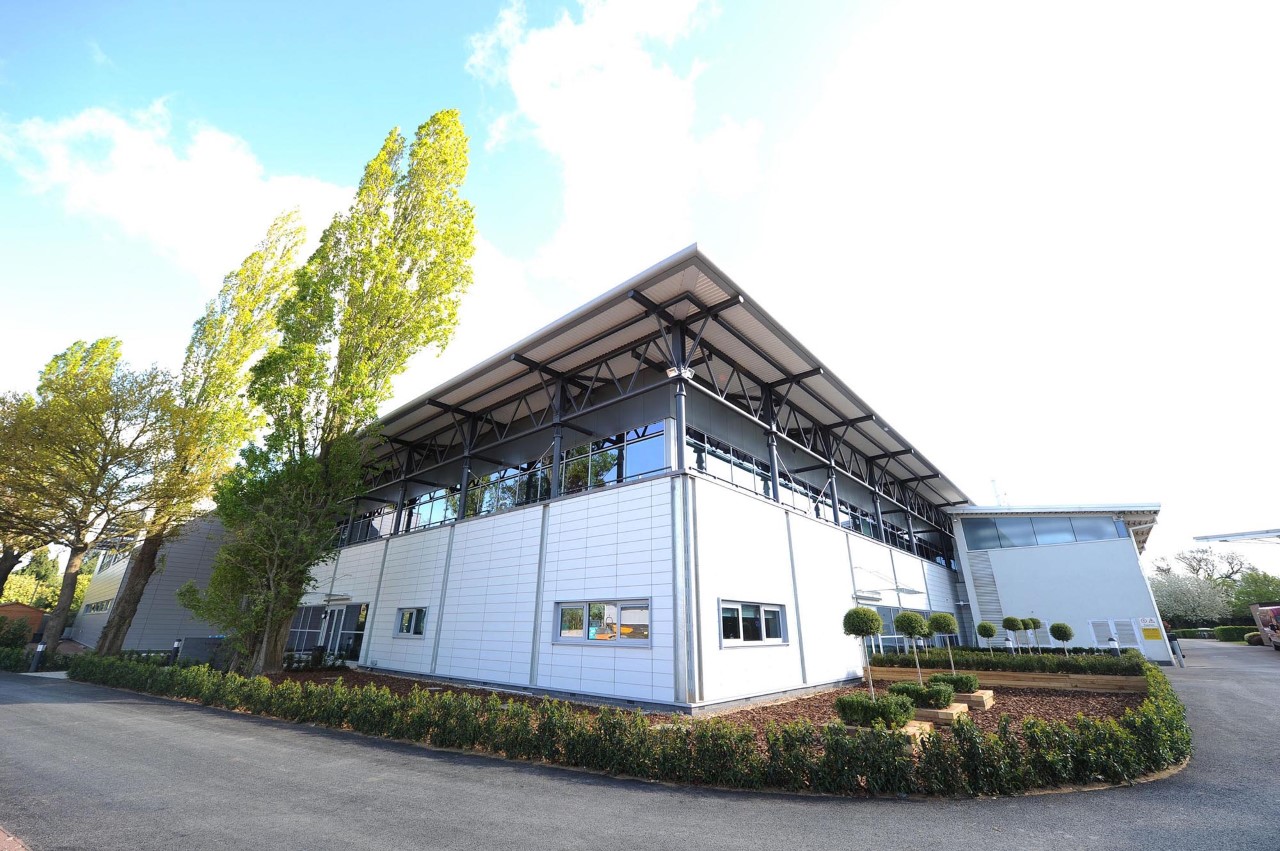
Annexed onto the changing quarters is a medical facility featuring the usual array of massage tables, tapes and ointments. We are ushered into the cryotherapy room and I briefly fear a Futurama style scenario unfolding. They operate a little like a sauna might in an alternate universe. Players spend a few minutes in temperatures of -60, before progressing into the chamber next door, where the thermometer plummets to -180. This was presumably handy to prepare for the Ostersunds away tie in February. Cryotherapy is considered a key facet of muscle recovery.
We are then taken through what used to be the primary gym at Colney, which still has some machines and gadgets kicking around. Occasionally, warm up and warm down sessions are led here. But the new gym is infinitely more spacious and 22nd Century. As we walk through to the new gymnasium, the walls are embossed with inspirational quotes. The academy players are housed in a slightly different area of the PPC.
As such, the walls that separate the academy section and the first team sector feature inspirational quotes, such as “What am I going to do today?” with a series of more suggestive sentences underneath (“to help the team”, “to improve myself” etc). Once the academy boys make their first team debut, the number above their changing quarters is painted gold, the prestige is intended to create competition and motivation between the players.
The walls are pristine white and the ceilings are glass to promote natural light and create an airy feel. Colney is surrounded by greenery, giving the illusion of a countryside escape. There are few external distractions here. We walk through to the new gym, which looks like the sort of facility Ivan Drago would have used if Rocky IV had been made in 2035.
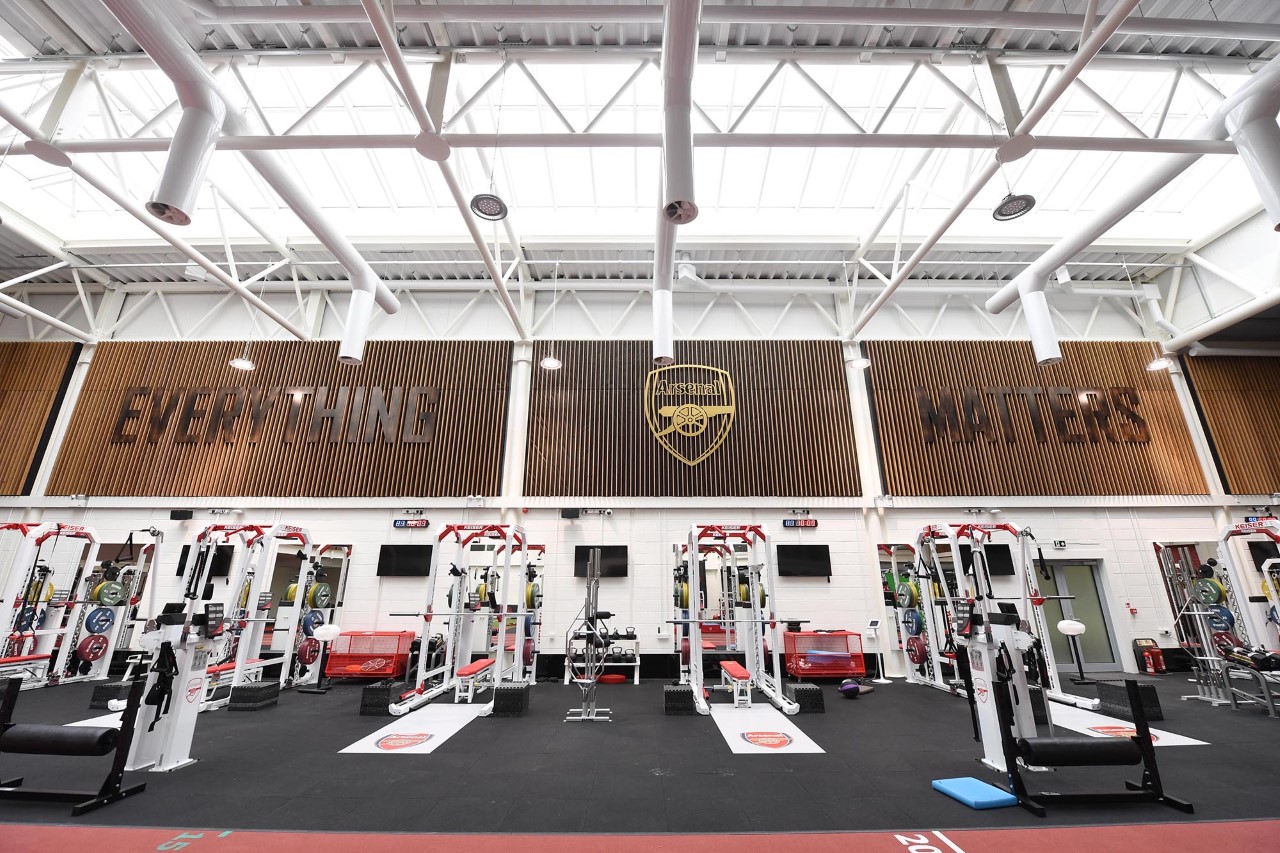
The phrase EVERYTHING MATTERS is suspended at the top of the wall of this high ceiling room. The floors have different levels of absorption to aid players recovering from muscle and ligament injuries. Effectively, they graduate from the hydrotherapy pool and in the gym they eventually move their way through the different gradients of flooring. So part of the floor is super spongy, causing you to tread a little like you are bounding through space.
There is a 40m running track through the epicentre of the gym and the machinery is, as you would expect, like something from Professor Frink’s laboratory. Players can just punch their name into the various weight machines and find their daily programme of reps and sets beamed back to them on an ipad. There is a 3D scanning facility which is able to detect a player’s fat levels.
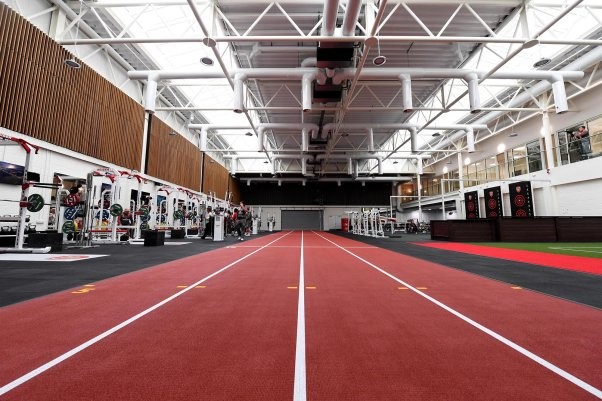
The 3D scanning facility is also able to pinpoint where the player’s genetic and physical strengths and weaknesses are. Arsenal also have pioneering virtual reality playback technology. Like most Premier League clubs, Arsenal use an aerial camera tracker for matches. So players can slip on a headset and be beamed right back into a real life game situation, through use of virtual reality, they can analyse the whole panorama of the pitch when they took a particular action.
Even more ingeniously, young players can slip on a headset and assume the virtual reality form of Mesut Özil or Pierre Emerick Aubameyang to observe their panorama when they took a particularly decisive action. Elite sports clubs are spending millions in pursuit of marginal gains like this. We walk upstairs to the presentation room, where Darren Burgess leads a presentation. En route, Sean O’Connor, Facilities Manager, takes us past the academy classrooms, which are fitted out with a suite of iMacs.
Academy players are led through their coaching badges now as part of their education, so they have a clear and immediate alternative route should playing careers not come to fruition. We sit in the presentation room, where the names of every single player to represent Arsenal’s first team are etched into the walls (there are 853 of them at the time of the visit). Burgess explains a slight restructure of the Player Performance Team over the summer.
Gary O’Driscoll leads the medical side and the team has been bolstered by Candy Crush data scientist Mikhail Zhilkin, who is expanding the club’s statistical analysis on the medical and performance side. The range and sophistication of data available to players is mind boggling to the point that it is impossible to fully relay here without making this article novel length.
At one point, we are shown a scattergraph based on the hamstring lengths of the current first team squad. Players can have sleep monitored if they choose, bespoke programmes are created for players based on their physical statistics. These programmes differ according to a player’s specific movements. For instance, some players rely on long distance sprinting, whereas others are likely to move in different directions constantly over much shorter spaces. Burgess reports that sprints have increased by 65% in the Premier League over the last 4 seasons.

StatDNA conduct analyses of other clubs too, with a database containing a profile on every player so Arsenal can measure themselves and scout opponents physically. So, for instance, if an opposing player tends to drop notably after the 65th minute, that information is all fed into Unai Emery, whose coaches often attend the daily Performance and Research Team briefing. Analysis of injury data is deliberately compiled by consultants to maintain independence.
Physical statistics are also married with psychology. The players’ psychological and emotional well-being is regularly charted and this can feed into individual programmes where necessary. Burgess explains that he is a big advocate of flotation tanks, though these aren’t mandatory – it is down to player choice.
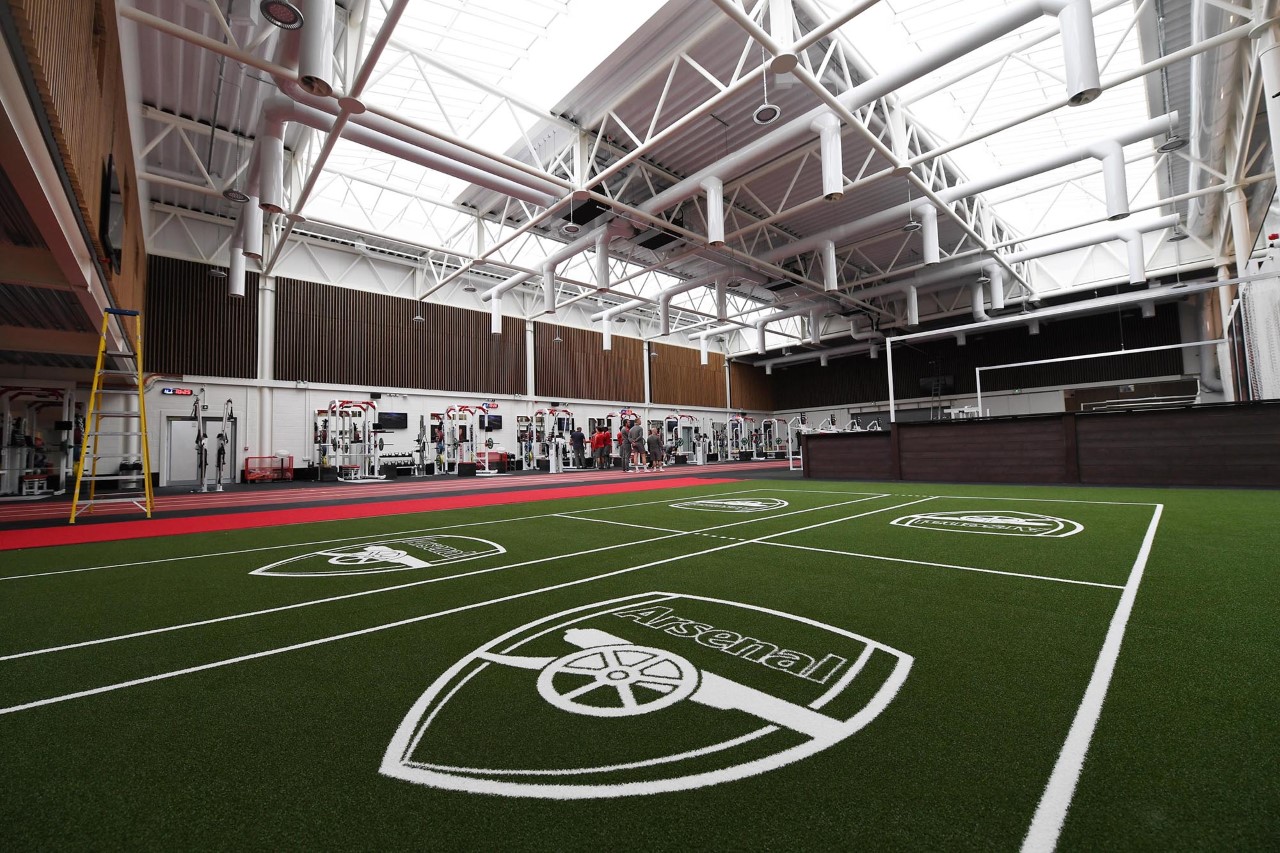
Burgess also talks a little bit about messaging and how that feeds the perception of injury management in particular. Arsenal choose to report on every injury and give prognoses as accurately as possible in public. They realise this approach is not without risk if return is delayed. Other clubs sometimes look to exaggerate recovery periods so an early return is seen as a ‘good news story.’
Arsenal, Burgess explains, will persist with a policy of openness and accuracy, which he understands potentially makes them vulnerable to public perception. In the spirit of openness, the Performance and Research Team has opened a Twitter account @ArsenalSEMS. Burgess also talked about striking the balance between pushing the players hard and not breaking them- aches and pains are the price of high tuning.
At one point, he tells us that the occasional injury is a natural symptom of hard work. He cites last season’s Carabao Cup Final, where both Manchester City and Arsenal racked up their highest running stats of the season. City suffered two hamstring injuries during the game whereas Arsenal reported a clean bill of health. But ultimately, City took the trophy with some ease. Handling player performance and its associated data is essentially an exercise in risk management.
A dizzying amount of data is made available to players and the coaching staff, right down to which sorts of exercises cause their heart rates the most stress- which can be key data in injury prevention. The current generation of players are accustomed to data having spent their youths playing football themed video games, like FIFA, Pro Evo and Football Manager. Many aspects of training are gamified to encourage competition. Players that post leading stats in the gym have their feats written up on the gymnasium walls.
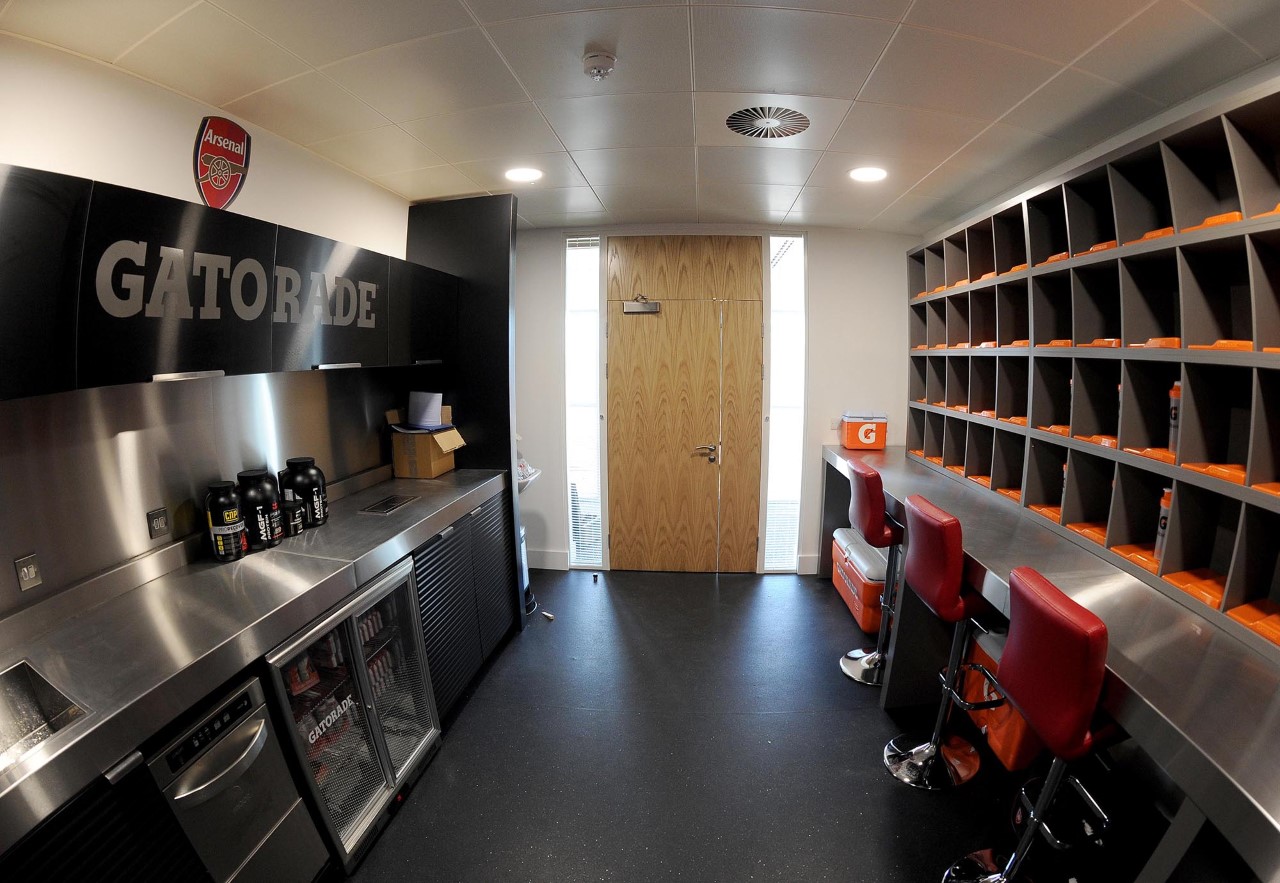
The level of detail is, frankly, intimidating. Generally, the perception of how an elite sports team operates in terms of performance and medicine is quite narrow and attending an evening like this is to watch the atom being split and a volcano of graphs, gadgets and a detailed organogram spewing out.
The Player Performance Centre is a little bit like a hive with hundreds of ants beavering away to ensure that Pierre Emerick Aubameyang’s hamstrings don’t explode as he bears down on goal.
As marginal gains become increasingly more important in football, let’s hope this work behind the scenes provides Unai Emery and his players with the extra edge they’ll need during what promises to be a challenging season ahead.





all fine and dandy. but we need some proper players with speed, skill, strength and stamina to do the stuff on the pitch.
Oh do piss the f**k off
You should change your @ to FIFA Bitch**
Correct. We need better players but Kroenke wont invest the money.
Thanks for the insight Tim. Great piece. That’s one of the reasons I love the Arseblog!
Would love to check out the facilities myself.
I’ve been following Arseblog News since its very first day and the blog since a while before that (which is a testament to the quality of content your team provides). I always look forward to Mr. Stillman’s in-depth pieces on tactics, players, life as a fan and whatnot. But especially based on the past few days, with the piece on Arsenal Ladies and now this, I have to doff my hat to the Arseblog Team. For a fan who doesn’t live in England and finds it harder and harder to feel a personal connection with the club in this increasingly… Read more »
I was about to say exactly this
Me too, minus the part about the ladies team. Find those articles too PC. Truth is it’s the Men’s team that piques the majority of the supports interest.
Thanks for that Mr Obvious. You’re completely right, we should just ignore any aspect of the club that isn’t the biggest draw card.
What an odd thing to say about the women’s team. If you don’t like, that’s fine – it’s not compulsory to read it.
But the Arsenal Women are a part of this football club, and we’re both happy and proud to give that team greater coverage.
It’s not PC, and you can just ignore it.
Well said Blogs.
Absolutely. They deserve plenty of coverage as they are not merely a side arm of the club, they are The Arsenal.
Personally I found it hard to get into it as the power simply isn’t there in comparison to the men’s game (coupled with a job that makes it hard enough to follow the men these days) but the achievements of Arsenal Ladies are extraordinary. You are not forced to click on any articles.
Atleast the Women team has won us Champions League.
Please don’t take this as advice or preaching or whatever but what I’ve found through legit trial and error from a professional, personal and whatever other aspects of life that may exist is this:
When one doesn’t have anything positive to say, it would be wise to be quiet. And when one has ONLY/MAINLY negative shit to say, then it would be extremely prudent to STFU. 😀
And this Mr. Bergkamp is regardless of whether said words are true to your actual character or not. 🙂
What a shitty, narrow-minded thing to say. It’s men like you – and let’s be honest, only a dude would say something stupid like this – that give the rest of us a bad name.
Point about how long we’ve been reading arseblog being a testament to quality of content is very valid. The fact that arseblogger and team focus on the club in it’s entirity and is not the click-bait loving, football fan equivalent of neymar is why they are the go to website for many genuine fans. Thanks.
Thank you 😉
Looks great but at 30 million I thought we at least get the world’s best hangover cure
“Drinkwater signed for […] Chelsea […] for a £35 million fee”
Great write up on what seems like an amazing facility. World class to the max.
Truly mind boggling how much info they have to keep track off as well. But like the article said, these are the fine margins.
Also really liked:
Academy players are led through their coaching badges now as part of their education, so they have a clear and immediate alternative route should playing careers not come to fruition.
Great concept ?
I’d love a day out there and put through my paces. Groupon voucher?
Punchbags….? So they do boxing routines….?
Excellent article. And pretty amazing considering the sprints and cones of Don Howe’s days.
Performance dropping after the 65th minute? Wenger said it was 70 minutes, hence his substitutions then.
We can see how things are changing under the new regime, exciting times…
The most important number is 1 – get 1 more goal than the oppo and finish 1st in the League (or cup).
There’s a danger that we believe a lot of other numbers/data are more important.
And this is all in service of that aim, hence the comment about Man City in the Carabao Cup Final. City got two muscle injuries but won comfortably, so that was a bad result.
Their seems to be a gab between the areas all this high tech stuff is designed to improve or provide an edge and the football we get to see.
Work constantly on your weaknessess to get better. The attitude is very important as many other things and they seem to be touching on what matters most. Getting the players out on the pitch in the best mental and physical state possible – and then the performance is totally in their own hands.
I prefer to think that the rounded off corners mentioned in the 3rd paragraph are there to stop players injuring themselves. I can just picture Ramsey needing three months off after bumping into a sharp corner
Would be rather odd to have the corners of a room concave rather than convex, just saying.
All this and Alexis Sanchez was not happy at Arsenal
No mention of the new veterinary facilities–but I don’t believe Humber and Atom can ever be happy with Mourinho.
“StatDNA conduct analyses of other clubs too, with a database containing a profile on every player so Arsenal can measure themselves and scout opponents physically”…
Arsenal player data is also readily available to those clubs that use StatDNA as well. Then, what advantage does that give Arsenal over those clubs?
Data is numbers , graphs , charts and qualitive stats. How you use available data to make a strategy pitting your strengths against someone’s weaknesses is what is important. Better strategies will come from smarter people who can assimilate the data into a plan that works
Arsenal acquired StatDNA .. don’t think it’s open to other clubs
“The 3D scanning facility is also able to pinpoint where the player’s genetic and physical strengths and weaknesses are.” – I really, really want to try this.
Good article, but the myth of marginal gains has allegedly been busted http://sportsscientists.com/2017/03/sports-science-marginal-gains-common-sense/?doing_wp_cron=1534336674.6442649364471435546875
Did you read that article you linked, Pip? Not meant as an attack. Just, this is not a debunking of the “marginal gains” concept (the last section is actually titled, ‘Objection to Context, Not Concept’) rather a critique of the branding and characters associated with the so-called “marginal gains” movement. I don’t think this applies to Arsenal, or the Player Performance Centre. Marginal gains is essentially a throwaway term. And as the article states the practices entailed are so old and too standard to even bother mention. What interests me are the methods used to gain advantages and the resources… Read more »
Indeed, being an elite athlete is so demanding on the body, you have to stop doing it less than half way through your life (assuming you conform to average life expectancy). It takes an enormous toll, I think we ‘layman’ hugely underestimate the physical strain of being an elite level footballer.
Actually, that article takes issue with the idea that marginal gains are a new idea propagated by two guys who have gotten rich off it. The central idea of the article is the finding marginal gains to increase performance is so obvious that everyone has been doing it in sport science forever. The article takes the idea that small improvements can yield noticeable results as obviously true… Which is exactly what Arsenal are doing here.
Can’t stress how important this is. No not just the facility, but Burgo opening up to the public and even the new Twitter account. As someone who worked for another PL club as a Sports Scientist, Arsenal under Wenger gained a reputation for being up themselves and insolar. The sports scence community is very small, right and generally support each other and aren’t open to each other. However one club that was known for never showing up or interacting with the community was Arsenal. They kept themselves to themselves and even held their own internal seminars rather than attending the… Read more »
Do you mean data about what they do in the company gym? Or on the pitch infront of millions of viewers?
Seems dumb.
Something from a US court judgement seems dumb?
There must be a “Y” in the day or something…
If I do a medical check up at my GP, does that mean my GP owns my data? /rollseyes The debate is that tactical data (game analysis, etc.) is owned by the club, which makes complete sense. The grey area is when it comes to individual data; such as injury-risk etc. Can clubs use that to negotiate contracts? But is it theirs? Shouldn’t it either be the player and the insurance company? And what if the player leaves? Currently the club still has the medical data, but is it theirs to keep? etc. In the world of HIPAA and GDPR,… Read more »
Interesting perspective Faisal.
The issue of who owns data about an individual and what that data can be used for needs to be debated in terms of ethics at all levels of society. We’ve seen the harm social media companies have caused by exploiting user consent for financial gain.
Arsenal should follow best practices, but we also have to be responsible with the data we get from players.
The 3D scanner thing identifying genetic weaknesses is a bit odd. If we do reach the stage of creating players in test tubes, then lets start with a couple of defenders please.
I am available at reasonable rates.
Great reading Tim. Thank you.
Thumbs up ?
Nice article, thanks. Goes to show the sophistication of the resources available to elite football clubs. It is a multi-million pound operation. The question is how to use this dizzying volume of data. Also how to make the individuals not feel they are part of a giant scientific experiment. In a lot of respects, athletes perform best when their head is clear. It is finding that balance between the complexity of data and the simplicity of performance.
Seems like a significant investment has been made in current and future players. Should consider using John Calipari/Matthew Kelly’s mantra, be the best version of you.
The use of vr fascinates me Have long thought the nfl should use it with QBs.
This is a fantastic article Tim. Good to see that Arsenal are investing in areas of the infrastructure to get the maximum out of the players we have. It’s not all about player recruitment and goes some way to explaining the limited budget this season. I would love to see Arsenal compete again at the highest level within our means. It would shove a huge finger up to the other clubs with ‘dodgy’ benefactors. It will take some years but I’m an Arsenal fan for the way we do things, what we represent as much as what I see on… Read more »